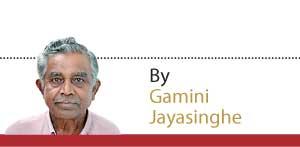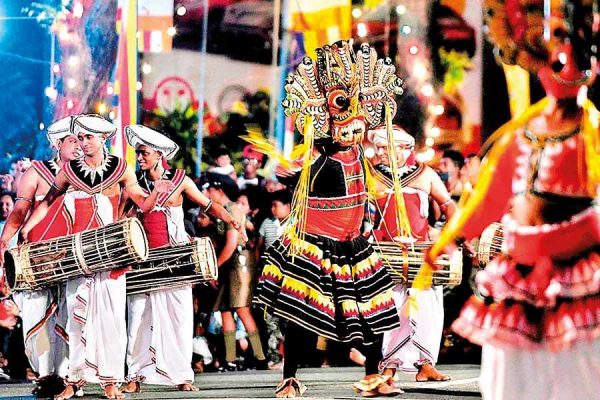Majestic Navam Perahera: Why Nawam Perahera stands tall-by Gamini Jayasinghe

Ven. Galaboda Gnanissara Maha Thera
Source:Dailymirror
- This pageant- conducted by Hunupitiya Gangaramaya- was originally known as Kolamba Perahera (Pageant of Colombo)
- The objects of this pageant were varied. Primarily it is to venerate the Triple Gem, the Buddha, His Doctrine, Dhamma and His disciples and the clergy
The Hunupitiya Gangaramaya Raja Maha Viharaya is of special significance to all irrespective of religious or racial differences both as a sacred place of worship and also as an institution providing facilities for youngsters to be useful citizens of the country.
or racial differences both as a sacred place of worship and also as an institution providing facilities for youngsters to be useful citizens of the country.
Due to the religious, social, cultural and educational activities undertaken and performed by this temple under the exemplary guidance and direction of the present incumbent of the temple Ven. Galaboda Gnanissara Maha Thera-fondly known as Podi Hamuduruwo- this temple has gained religious, social, cultural and institutional reputation.
It was during the time of Ven. Devinuwara Sri Jinaratana Nayake Thera that this temple was transformed into a nationally and internationally reputed religious institution. This Nayake Thera, who was a pupil of Ven. Hikkaduwe Sri Sumangala Nayake Thera, was liked by the people and they enabled him to transform a hermitage- on a marshy land- to a popular place of Buddhist worship. The transformation had taken place within a very short period.
At present, Gangaramaya is the most popular place of Buddhist worship within the Colombo Municipal limits. This temple carries the three main features; Sharirika Dhatu (the physical remains of the Enlightened One), Maha Bodhi (the sacred Bo tree) and Buddha Rupa (Images of Buddha). The main features of the temple include the Viharaya (main temple), the chaittiya (Pagoda) the Bo tree, Vihara Mandiraya Sima Malakaya and the Relic chamber. Gangarama Sima Malakaya is unique in its structure being located in the middle of the Beire Lake. This structure is so famous today that the whole temple premises are known as Sima Malakaya.
In addition a museum, a library and a traditional hall , a three storied Pirivena, an educational hall and a dinning hall are also in the premises.
Kolamba Perahera
The Navam Perahera (Pageant) is conducted annually during the month of Navam (February) by Gangaramaya Raja Maha Viharaya in Colombo to illustrate one of the most prestigious Buddhist historical events. This pageant- conducted by Hunupitiya Gangaramaya- was originally known as Kolamba Perahera (Pageant of Colombo) presumably because this is the only pageant parading the streets of Colombo. Since this pageant is conducted within the Municipal limits of Colombo tens of thousands of spectators (including a large number of foreign tourists) come to witness it.
Dhamma Chakka Pavattana Sutta denotes the turning the wheal of righteousness and it was the first sermon of the Buddha.
The occasion for conducting this pageant was the commencement of the first sermon of the Buddha – Dhamma Chakka Pavattana Sutta at Isipatana. However, due to the ill health of the incumbent Thera and a number of other reasons the pageant could not be conducted annually.
“In place of the former Kolamba Esala Perahera an annual pageant is conducted during the month of Navam (February). This new practice began in1979 under the state patronage provided by the then Prime Minister R. Premadasa.”
In place of the former Kolamba Esala Perahera an annual pageant is conducted during the month of Navam (February). This new practice began in1979 under the state patronage provided by the then Prime Minister R. Premadasa. The objects of this pageant were varied. Primarily it is to venerate the Triple Gem, the Buddha, His Doctrine, Dhamma and His disciples and the clergy. Another objective is to commemorate the appointment of Arahants Sariputta and Moggallyana by the Blessed One as His chief disciples. The top most positions in the Order of Maha Sangha were conferred on Arahant Sariputta (Dakunath Sau) and Arahant Moggallyana (Wamath Sau) by the Buddha at the first Congregation on Navam Full Moon Poya day.
Gangaramaya Navam Perahera comprises a multitude of participants who in unison make the pageant magnificent.
Dhamma Chakka Pavattana Sutta denotes the turning the wheal of righteousness and it was the first sermon of the Buddha.
The occasion for conducting this pageant was the commencement of the first sermon of the Buddha – Dhamma Chakka Pavattana Sutta at Isipatana. However, due to the ill health of the incumbent Thera and a number of other reasons the pageant could not be conducted annually.
“In place of the former Kolamba Esala Perahera an annual pageant is conducted during the month of Navam (February). This new practice began in1979 under the state patronage provided by the then Prime Minister R. Premadasa.”
In place of the former Kolamba Esala Perahera an annual pageant is conducted during the month of Navam (February). This new practice began in1979 under the state patronage provided by the then Prime Minister R. Premadasa. The objects of this pageant were varied. Primarily it is to venerate the Triple Gem, the Buddha, His Doctrine, Dhamma and His disciples and the clergy. Another objective is to commemorate the appointment of Arahants Sariputta and Moggallyana by the Blessed One as His chief disciples. The top most positions in the Order of Maha Sangha were conferred on Arahant Sariputta (Dakunath Sau) and Arahant Moggallyana (Wamath Sau) by the Buddha at the first Congregation on Navam Full Moon Poya day.
Gangaramaya Navam Perahera comprises a multitude of participants who in unison make the pageant magnificent.
Whip crackers
Whip crackers serve a number of purposes. Firstly it is the means of clearing the way for the main pageant. Consequent to the performance of Whip crackers spectators confine themselves to the pavement and leave the road entirely for the pageant to pass without any disruption. Secondly it is a signal that the main pageant is approaching. It is said that even the celestial beings hear this sound which they think is an invitation made to them to watch the pageant. Devotees – young and old- including school children walk behind them; some carrying flags and banners with others carrying trays of flowers.
Elephants
Beautifully adorned elephants including tuskers provide majesty and elegance to the procession. The tusker of the temple carries the relic casket on its back. As in the Sri Dalada Maligawa Esala Perahera in Kandy, Kelaniya Raja Maha Viharaya’s Durutu Perahera and the pageant conducted by the Bellanwila Raja Maha Viharaya we see elephants walk elegantly in the Gangaramaya Navam Perahera too.
Drama performers
The performers at the Gangaramaya Raja Maha Viharaya Navam Perahera can be categorised into four groups. There are ordinary dancing teams representing Kandyan dancers, low country dancers and Sabaragamuwa dancers. The world’s oldest and most ubiquitous musical instrument – the drum -is used in all these dancing performances. Various kinds of drums such as the “Getaberaya” ( the drum used in Kandyan dancing), “Magul Beraya” ( the drum used by the royalty, “Yak Beraya” the drum used by devil priests, “Udakkiya “ (the drum which is small in the middle and “Rabana” Tambourine) are beaten to produce rich and melodious sounds in harmony with the dancers and “Vannam” or songs of the performers. In addition a pair of symbols or “Talampota” are used in all these dancing performances.
Hewisi drummers
The most important group of performers is the group of Hewisi drum players. They produce a drum roar with the large drum ‘Daula’, the double drum “Tammattama” and the trumpet “Horanewa”. Meanwhile, the conch shell blowers produce gentle and prolonged sounds increasing the serenity of the atmosphere.
Dancers in their costumes look elegant when they move in the procession. They sing “Vannams” while dancing. Vannams are metrical verses sung by dancers to produce lyrical music in their performances. There are eighteen vannams. When the performers dance to the tune of the Gajaga vannama they move just like elephants.
The most important dancing performance
A special kind Kandyan dancing is known as “Ves Natuma”. These dancers have to undergo training during a long period of time before they are considered qualified to perform.
Panteru dancers form another group of dancing. Every performer has a circular instrument called “Panteru” which produces a clinging sound. This makes the performances melodious..
Stilt walkers
Boru Kakul Karayo or Stilt walkers produce special colour to the Gangaramaya Navam Perahera. The performers walk high above the ground on two long poles or walking sticks with peddles to rest their feet. They sneer at the spectators from above and provide them with entertainment
Organising of the processions
A significant feature regarding this pageant is that it is planned and organised in an excellent manner. The perahera parades a number of streets and the main road in front of Gangaramaya Viharaya and along Beira Lake – Navam Mawatha. Seating accommodation is provided for the spectators. The route for the pageant is determined and the places where the Maha Sangha, elephants, dancers, drummers, torch bearers office bearers and others who partake in the pageant are well directed. Nothing is left to chance.
The arrangements for the pageant are made by the Gangaramaya Temple and all the organising is handled by young people associated with the temple under the able direction of the chief incumbent of the temple Podihamuduruwo.








